Outstanding balances on small business commercial and industrial (C&I) loans in the third quarter of 2020 grew over 80 percent compared with the third quarter of 2019 related primarily to Paycheck Protection Program (PPP) lending, but at a sharply lower rate compared with the second quarter of 2020. Outstanding balances secured by Small Business Administration (SBA) guarantees remained high, increasing from 47 percent in the second quarter to 51 percent in the third quarter. New small business C&I loan balances grew 15.3 percent from the same period in 2019, but declined 88.9 percent from the previous quarter, reflecting the mid-quarter close of the SBA’s PPP program. Of 118 respondents to the third quarter survey, most, on net, indicated tightening credit standards and loan terms, and decreasing credit quality. Credit line usage decreased for the second consecutive quarter and application approval rates fell across all bank sizes. Among those responding to the pandemic-related, special question asked in this quarter’s survey, 93 percent indicated they were confident or somewhat confident in their ability to assess the financial position and repayment capacity of small business borrowers, an increase from 82 percent in the second quarter.
Chart 1: PPP Lending Drives Year-Over-Year Increase in Outstanding Small Business C&I Loans
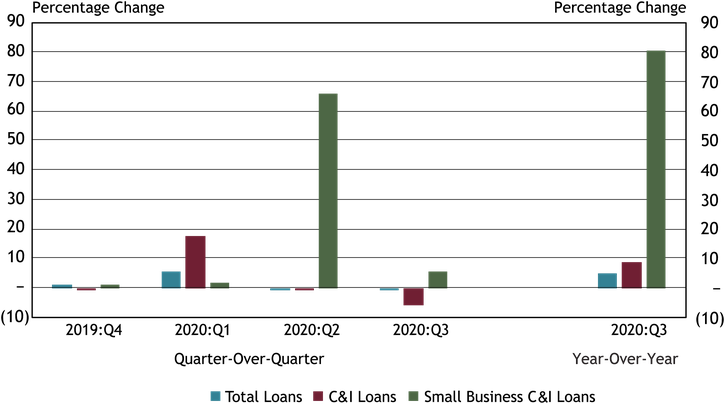
Note: Items are calculated using a subset of 88 respondents that completed the FR 2028D for the last five quarters surveyed.
Sources: Call Report, schedule RC-C Part I, items 4. Commercial and Industrial Loans and 12. Total loans and leases held for investment and held for sale; and FR 2028D, items 4.b and 5.c.
Small business C&I loan balances increased 80.7 percent from the third quarter of 2019. This was due primarily to a significant increase in loans guaranteed by the SBA, driven by borrowings through the PPP. Outstanding small business C&I loan balances grew more slowly compared with the dramatic growth in the previous quarter, increasing 5.6 percent. Compared with the third quarter of 2019, total loan and total C&I loan balances increased 4.9 and 8.7 percent, respectively, driven by increases in the first quarter of 2020.
Chart 2: Outstanding Loan Balances Secured by SBA Guarantees Increase
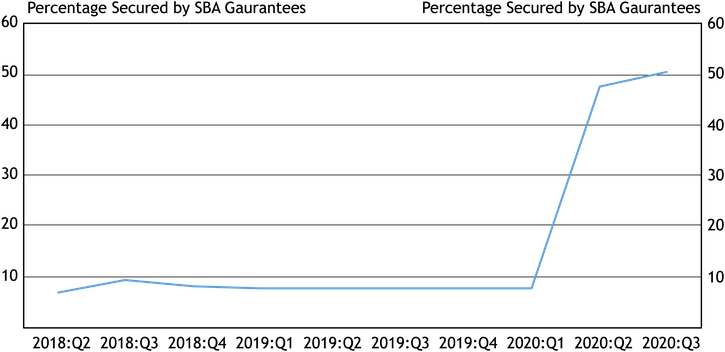
Source: FR 2028D, items 4.b, 4.j, 5.c and 5.i.
The percentage of outstanding small business C&I loan balances secured by the SBA continued to increase from 47 percent to 51 percent in the third quarter. Prior to the second quarter of 2020, the percent of balances secured by the SBA had ranged from 7 to 9 percent.
Chart 3: New Small Business C&I Term Loan and Credit Line Balances Decrease Quarter-Over-Quarter
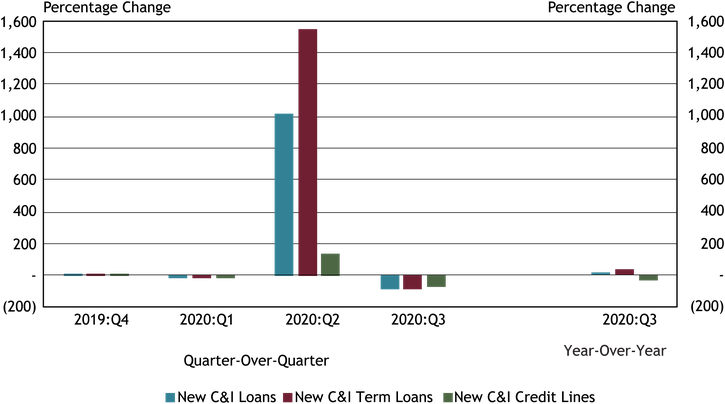
Note: Items are calculated using a subset of 88 respondents that completed the FR 2028D for the last five quarters surveyed. All loan types referenced in Chart 3 refer to small business lending.
Source: FR 2028D, items 7.b and 10.c.
Following record quarter-over-quarter increases in the second quarter, new small business C&I loan balances decreased by 88.9 percent due primarily to the close of the SBA’s PPP in August of 2020. Compared with the third quarter of 2019, new C&I loan balances increased 15.3 percent, driven by a 43.0 percent increase in term loans.
Chart 4: Fixed Rate Credit Line Usage Increases as Variable Rate Credit Line Usage Decreases
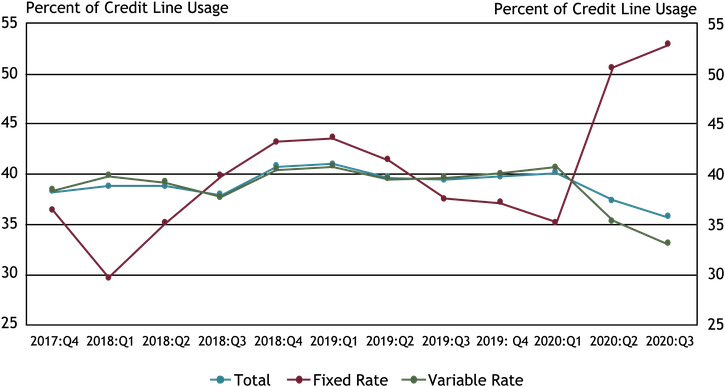
Source: FR 2028D, items 5.b and 5.c.
Use of fixed rate small business C&I lines of credit increased from 50.7 percent in the second quarter to 52.9 percent in the third quarter, while use of variable rate small business C&I credit lines decreased from 35.3 percent in the second quarter to 33.0 percent in the third quarter. Total small business C&I credit line usage decreased from 37.4 percent in the second quarter to 35.8 percent in the third quarter.
Chart 5: Interest Rates Increase Across Most New Loan Categories
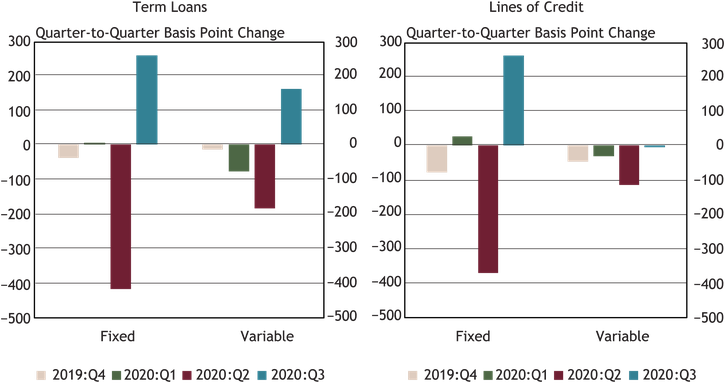
Note: Items are calculated using a subset of 88 respondents that completed the FR 2028D for the last five quarters surveyed.
Source: FR 2028D, items 7.c and 10.d.
Weighted average rates on new fixed and variable rate term loans and fixed rate lines of credit increased in the third quarter, following significant decreases in the second quarter. The largest increases in interest rates were reported for fixed rate term loans and lines of credit, both of which increased by 260 basis points. Variable rate lines of credit remained stable. The increase in fixed rates for term loans and lines of credit primarily can be attributed to banks originating fewer PPP loans with the August 2020 close of the SBA program.
Chart 6: Interest Rates on Fixed Rate Term Loans and Lines of Credit Lower than Variable Rate Term Loans and Lines of Credit
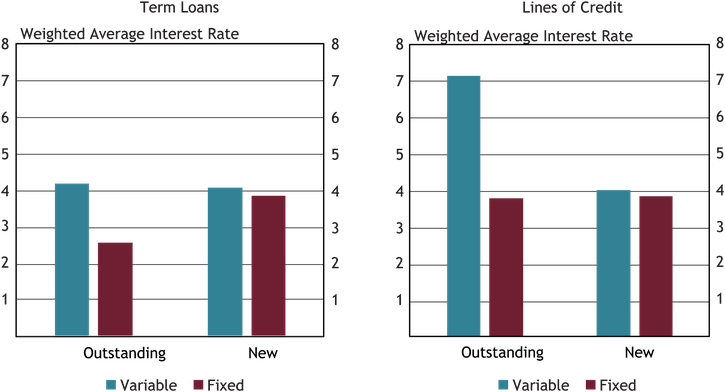
Note: Average interest rates are weighted by the dollar volume of new small business C&I loans.
Source: FR 2028D, items 4.c, 5.d, 7.c and 10.d.
Weighted average interest rates on variable and fixed rate new and outstanding small business C&I term loans and lines of credit ranged from 2.58 percent to 7.16 percent in the third quarter. The weighted average rates for fixed rate small business C&I term loans and lines of credit were lower than the corresponding rates for variable rate small business C&I term loans and lines of credit. Weighted average variable rates on outstanding term loans and lines of credit were the highest, at 4.21 and 7.16 percent, respectively, while weighted average rates on outstanding fixed rate term loans and lines of credit were the lowest at 2.58 and 3.81 percent, respectively._
Chart 7: Percent of Loans at Interest Rate Floor Increases
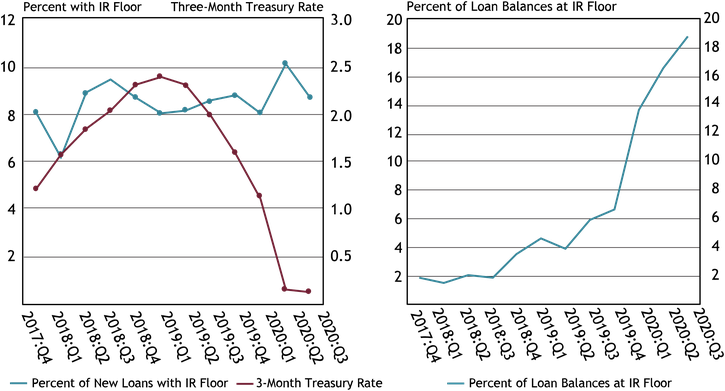
Source: FR 2028D, items 4.o, 5.n, 7.m, 7.o, 10.l and 10.n.; Federal Reserve Bank of St. Louis FRED, 3-Month Treasury Constant Maturity Rate.
The percent of new small business C&I loans with interest rate floors decreased in the third quarter to 8.7 percent, while the percent of total small business C&I loan balances at interest rate floors increased to 18.9 percent. The increase in the percent of loan balances at interest rate floors is attributed primarily to the falling rate environment, with the 3-Month U.S. Treasury Rate inching lower to 0.11 percent.
Chart 8: Large Bank Respondents Drive Net Decline in Overall Credit Line Usage
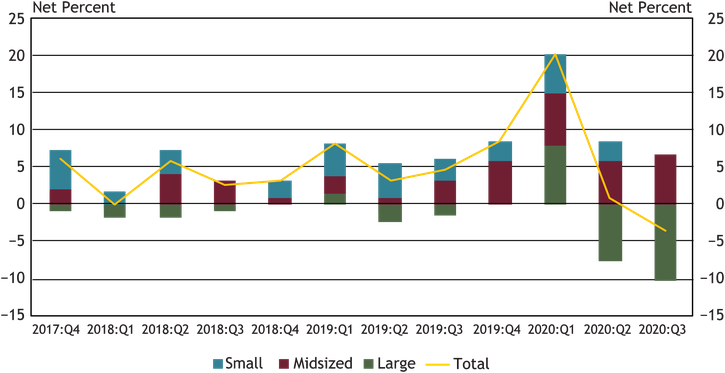
Notes: Chart 8 shows diffusion indexes for credit line usage. The diffusion indexes show the difference between the percent of banks reporting decreased credit line usage and those reporting increased credit line usage. Net percent refers to the percent of banks that reported having decreased (“decreased somewhat” or “decreased substantially”) minus the percent of banks that reported having increased (“increased somewhat” or “increased substantially”). (See footnote 2.)
Source: FR 2028D, items 11 and 12.
The percentage of respondents indicating a change in credit line usage, whether an increase or decrease, declined from 58 percent in the second quarter to 44 percent in the third quarter. While responses were split nearly evenly between increases and decreases, on net, about 3 percent of respondents indicated a decrease in credit line usage, primarily driven by large banks. This is the first time since the start of the survey that an aggregate net decrease in credit line usage has been reported. Of banks reporting a change in credit line usage, 75 percent cited change in local or national economic conditions and 71 percent cited change in a borrower’s business revenue or other business specific conditions as very important reasons for a change.
Chart 9: Most Respondents Report Weaker Loan Demand
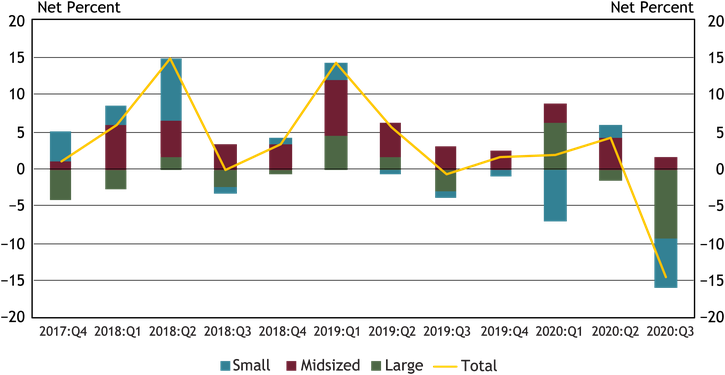
Notes: Chart 9 shows diffusion indexes for loan demand. The diffusion indexes show the difference between the percent of banks reporting weakened loan demand and those reporting stronger loan demand. Net percent refers to the percent of banks that reported having weakened (“moderately weaker” or “substantially weaker”) minus the percent of banks that reported having stronger loan demand.
Source: FR 2028D, item 13.
In the third quarter, 50 percent of banks reported a change in loan demand. On net, about 9 percent of large banks indicated weaker loan demand, compared with about 7 percent of small banks. In contrast, about 2 percent, on net of midsized banks reported stronger loan demand. On net, across all bank sizes, respondents reported a 14 percent decrease in loan demand, the weakest reported loan demand since the start of the survey.
Chart 10: Application Approval Rates Decrease for All Bank Sizes
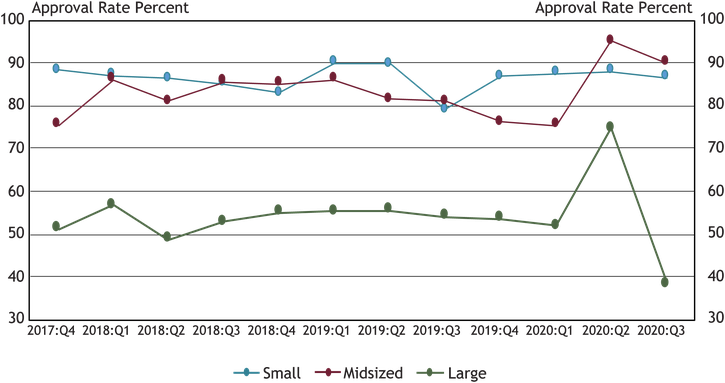
Source: FR 2028D, items 14.a and 17.
Application approval rates for large banks reached their lowest levels since the start of the survey, decreasing from 75 percent in the second quarter to 38 percent in the third quarter. Application approval rates for small and midsized banks also decreased, from 88 and 95 percent in the second quarter of 2020 to 87 and 90 percent in the third quarter, respectively. The three most commonly cited reasons for denying a loan were borrower financials, collateral and credit history.
Chart 11: Decreases in Credit Quality Reported Across All Bank Sizes
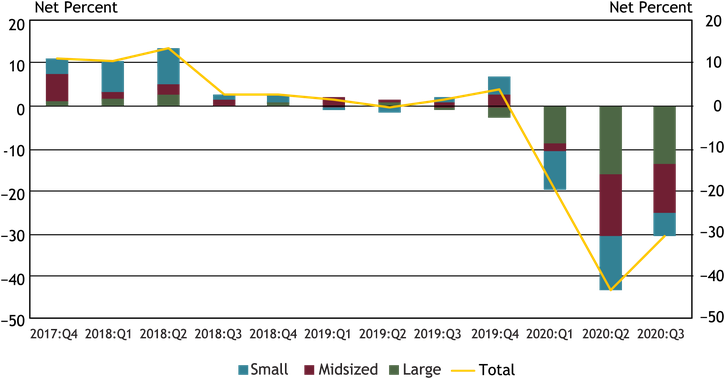
Notes: Chart 11 shows diffusion indexes for credit quality of applicants. The diffusion indexes show the difference between the percent of banks reporting a decline in credit quality and those reporting improvement in credit quality. Net percent refers to the percent of banks that reported declining credit quality (“declined somewhat” or “declined substantially”) minus the percent of banks that reported improving credit quality (“improved somewhat” or “improved substantially”).
Source: FR 2028D, items 24 and 25.
In the third quarter, about 31 percent of banks, on net, reported a decrease in the credit quality of applicants. This is the third consecutive period in which respondents of all bank sizes, on net, reported a decrease. Of the respondents reporting a change in credit quality, whether an increase or decrease, 54 percent cited the liquidity position of business borrowers as a very important reason for a change. Other commonly cited reasons for a change include debt-to-income level of business owners, prospects for business growth or enterprise values, and recent business income growth.
Chart 12: Banks Tighten Credit Standards and All Loan Terms
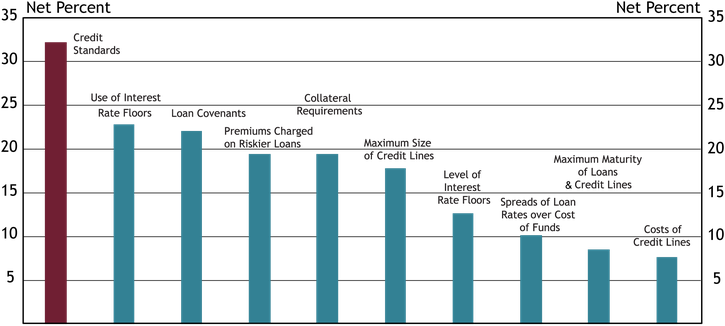
Note: Chart 12 shows diffusion indexes for credit standards (red bar) and various loan terms. The diffusion indexes show the difference between the percent of banks reporting tightening terms and those reporting easing terms. Net percent refers to the percent of banks that reported having tightened (“tightened somewhat” or “tightened considerably”) minus the percent of banks that reported having eased (“eased somewhat” or “eased considerably”).
Source: FR 2028D, items 18, 19, 20 and 22.
About 34 percent of respondents reported a change in credit standards in the third quarter, down about 15 percent from the second quarter. Of banks indicating a change in credit standards, 32 percent on net reported tightening their credit standards (as shown in Chart 12), a decrease of about 11 percent from the previous quarter.
On net, respondents indicated that all loan terms tightened, with use of interest rate floors and loan covenants tightening the most. Respondents reporting tightening credit standards or loan terms in the third quarter cited a less favorable or more uncertain economic outlook and worsening industry specific problems.
Chart 13: COVID-19 Pandemic and its Impact on Small Business Lending
A special question in the third quarter 2020 collection of the Small Business Lending Survey asked:
a. Approximately what percentage of your small business customers are still in a period of forbearance?
b. Have you been able to confidently assess the financial position/repayment capacity of your small business borrowers?
c. What impact do you expect lapsing government stimulus/programs will have on the financial condition of your small business borrowers?
The data collection period for the survey took place in November. Responses to this special question may be more reflective of a point in time rather than the impact faced by an institution on September 30, 2020. Ninety percent of reporting institutions (106) provided an answer to the special question. Of those institutions that responded:
Eighty-eight percent indicated 0-25% of small business customers are still in a period of forbearance:
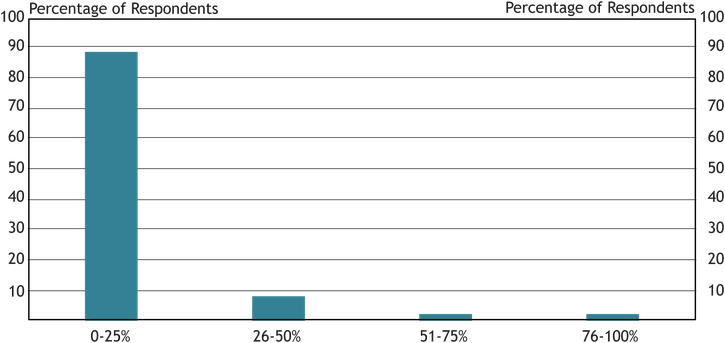
Sixty-six percent of respondents indicated they were somewhat confident in their ability to assess the financial position/repayment capacity of their small business borrowers, up from 55 percent in the second quarter. Respondents indicating that they were confident in their ability to assess the financial position/repayment capacity of their small business borrowers remained at 27 percent, unchanged from the second quarter.
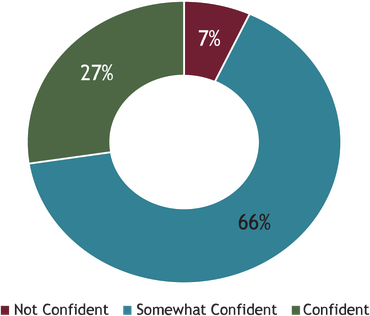
Fifty-eight percent indicated they expected a somewhat negative impact of lapsing government stimulus/programs on the financial condition of their small business borrowers:
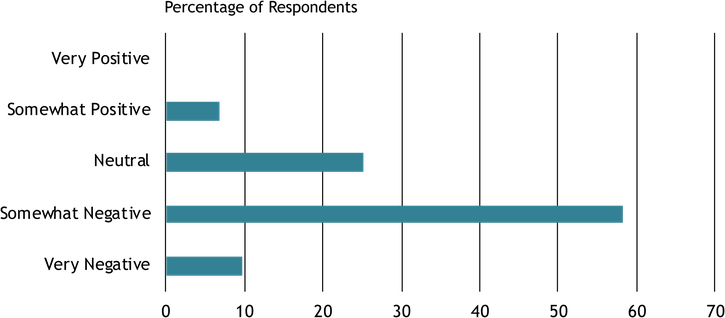
Other contributors to this release included Nicholas Bloom, Rosine Boni, Dan Harbour, Thomas Hobson, Alli Jakubek, and Tony Walker.
Contact Us
For questions or comments about this survey, contact us at KC SRM FR2028D Survey.
Endnotes
-
1
The interest rates for outstanding fixed rate lines of credit have been revised for Chart 6 in the 2020:Q1 and 2020:Q2 releases due to a calculation error. These releases can be found here.
-
2
Small banks have total assets of $1 billion or less, midsized banks have total assets between $1 billion and $10 billion and large banks have total assets greater than $10 billion.
